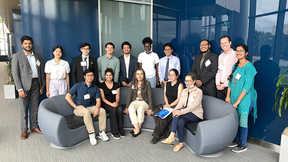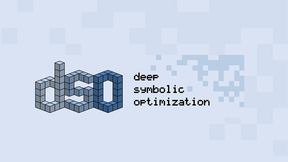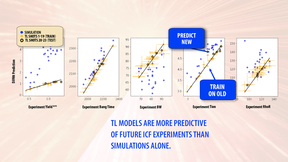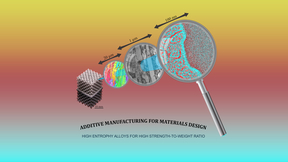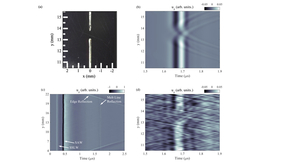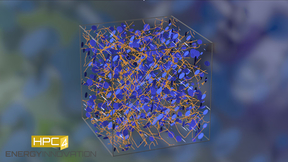Back
Computing
Manufacturing Day webinar to highlight HPC’s impact on climate change, energy efficiency
The High Performance Computing for Energy Innovation (HPC4EI) initiative will hold a special webinar on Oct. 7 to celebrate Manufacturing Day and provide a forum for industry experts and Department of Energy (DOE) scientists to discuss how HPC can help combat climate change and improve energy efficiency. The virtual event begins at 8 a.m. PDT and brings together panelists…
LLNL and Case Western Reserve University to continue collaboration
The leaders of Case Western Reserve University and Lawrence Livermore National Laboratory (LLNL) signed a memorandum of understanding (MOU) to accelerate their efforts in shared areas of excellence. After three years of growing institutional collaboration in such areas as energy, materials science and polymer processing, Case Western Reserve President Eric W. Kaler…
LLNL team claims top AI award at international symbolic regression competition
A Lawrence Livermore National Laboratory (LLNL) team claimed a top prize at an inaugural international symbolic regression competition for an artificial intelligence (AI) framework they developed capable of explaining and interpreting real-life COVID-19 data. Hosted by the open source SRBench project at the 2022 Genetic and Evolutionary Computation Conference (GECCO), the…
LLNL joins forces with supercomputing centers in Germany, the UK and the US to form IASC
Lawrence Livermore National Laboratory (LLNL) has signed a memorandum of understanding with high performance computing (HPC) facilities in Germany, the United Kingdom and the United States, jointly forming the International Association of Supercomputing Centers (IASC). LLNL and co-founders — the Science and Technology Facilities Council (STFC) Hartree Centre, the National…
Lab researchers win top award for machine learning-based approach to ICF experiments
The IEEE Nuclear and Plasma Sciences Society (NPSS) announced a Lawrence Livermore National Laboratory (LLNL) team as the winner of its 2022 Transactions on Plasma Science (TPS) Best Paper Award for their work applying machine learning to inertial confinement fusion (ICF) experiments. In the paper, lead author Kelli Humbird and co-authors propose a novel technique for…
New class of 3D-printed alloys brings more flexibility to super-strong metal parts
Metal 3D printing is used to produce components for many commercial applications, particularly in the transportation sector, where printing methods such as laser powder bed fusion (L-PBF) can produce super-strong and ultralight complex-shaped components that cannot be manufactured with conventional techniques. But while laser-based methods enable the manufacturing of…
Research finds mechanically driven chemistry accelerates reactions in explosives
Scientists at the Lawrence Livermore National Laboratory (LLNL) Energetic Materials Center and Purdue University Materials Engineering Department used simulations performed on the LLNL supercomputer Quartz to uncover a general mechanism that accelerates chemistry in detonating explosives critical to managing the nation’s nuclear stockpile. Their research is featured in the…
LLNL researchers chart progress in architected materials that respond to external stimuli
Recent advances in pre-programmed architected materials could enable new functions that can evolve in response to their environments or external stimuli, according to Lawrence Livermore National Laboratory (LLNL) researchers. In a paper published by Nature Reviews Materials, LLNL researchers provide an overview of the progress made in responsive architected materials that…
Multi-lab High Performance Storage System collaboration marks 30 years of data storage
Lawrence Livermore National Laboratory (LLNL) and the rest of the Department of Energy (DOE) national laboratories produce an astronomical amount of data every year. As the volume of data generated from DOE high performance computing (HPC) continues to reach increasing scales of magnitude and new levels of importance for decision-making, where does all this data go and how…
El Capitan testbed systems rank among top 200 of world’s most powerful computers
As the U.S. welcomed the world’s first “true” exascale supercomputer, three predecessor machines for Lawrence Livermore National Laboratory’s (LLNL) future exascale system El Capitan managed to rank highly on the latest Top500 List of the world’s most powerful supercomputers. Organizers announced the list at the International Supercomputing Conference in Hamburg, Germany…
LLNL and Amazon Web Services to cooperate on standardized software stack for HPC
Lawrence Livermore National Laboratory (LLNL) and Amazon Web Services (AWS) have signed a memorandum of understanding (MOU) to define the role of leadership-class high performance computing (HPC) in a future where cloud HPC is ubiquitous. Under the MOU, LLNL and AWS will explore software and hardware solutions spanning cloud and on-premises HPC environments, with the goal…
HPCIC webinar series to highlight LLNL/Hartree Center industry engagement and joint research
Lawrence Livermore National Laboratory (LLNL) and the United Kingdom’s Hartree Centre are launching a new webinar series intended to spur collaboration with industry through discussions on computational science, high performance computing (HPC) and data science. The first Hartree–Livermore joint webinar on Computational Science (HLCS) takes place May 24, where speakers…
NNSA and Cornelis Networks to collaborate on next-generation high-performance networking
The U.S. Department of Energy’s (DOE) National Nuclear Security Administration (NNSA) today announced the award of an $18 million contract to Cornelis Networks for collaborative research and development in next-generation networking for supercomputing systems at the NNSA laboratories. The Next-Generation High Performance Computing Network (NG-HPCN) project for the NNSA’s…
HPC4Energy Innovation initiative launches new call for proposals
The Department of Energy (DOE) today launched the spring 2022 solicitation for the High Performance Computing for Energy Innovation (HPC4EI) initiative, seeking proposals from industry that address key energy and decarbonization-related challenges in domestic manufacturing. The latest HPC4EI funding opportunity is sponsored by the HPC4Manufacturing (HPC4Mfg) Program, one…
Laser-based ultrasound detects defect-producing features in metal 3D printing
Lawrence Livermore National Laboratory (LLNL) researchers have developed a new all-optical ultrasound technique capable of performing on-demand characterization of melt tracks and detecting formation of defects in a popular metal 3D printing process. In a paper published by Scientific Reports, Lab researchers propose a diagnostic using surface acoustic waves (SAW),…
NASA funds LLNL to demonstrate 'replicator' 3D printer to produce cartilage in space
The National Aeronautics and Space Administration (NASA) announced April 15 it has awarded Lawrence Livermore National Laboratory (LLNL) and a private company with funding to develop LLNL’s revolutionary volumetric additive manufacturing (VAM) 3D printing technology to produce artificial cartilage tissue in space. The award, one of eight projects selected by NASA’s In…
Livermore WiDS provides forum for women in data science
Lawrence Livermore National Laboratory (LLNL) celebrated the 2022 Global Women in Data Science (WiDS) conference on March 7 with its fifth annual regional event, featuring workshops, mentoring sessions and a discussion with LLNL Director Kim Budil, the first woman to hold that role. For the second straight year, the WiDS Livermore event was entirely virtual due to the…
Machine learning model finds COVID-19 risks for cancer patients
If a cancer patient tests positive for COVID-19, are they more likely to become hospitalized from the disease? That depends on certain risk factors, according to a new study by researchers at Lawrence Livermore National Laboratory (LLNL) and the University of California, San Francisco (UCSF), who looked to identify cancer-related risks for poor outcomes from COVID-19…
Register for materials-focused HPC4EI virtual event
Registration is open for the High Performance Computing for Energy Innovation (HPC4EI) initiative’s upcoming virtual event on April 8, a webinar highlighting the impact of high performance computing on material design and predicting material performance. Free to the public, the “Focus on Materials” event will feature talks by U.S. Department of Energy (DOE) national…
LLNL team models COVID-19 disease progression and identifies risk factors
A Lawrence Livermore National Laboratory (LLNL) team has developed a comprehensive dynamic model of COVID-19 disease progression in hospitalized patients, finding that risk factors for complications from the disease are dependent on the patient’s disease state. Using a machine learning algorithm on a dataset of electronic health records (EHRs) from more than 1,300…



